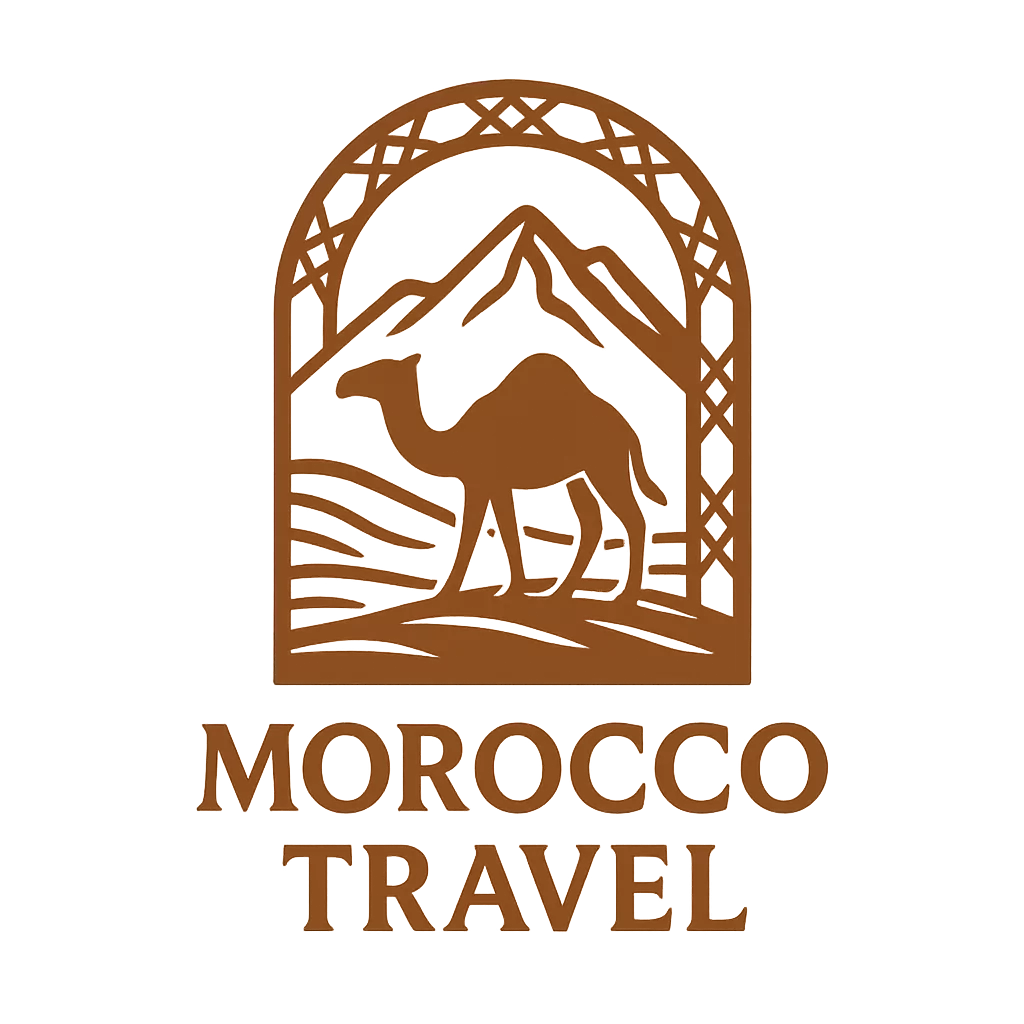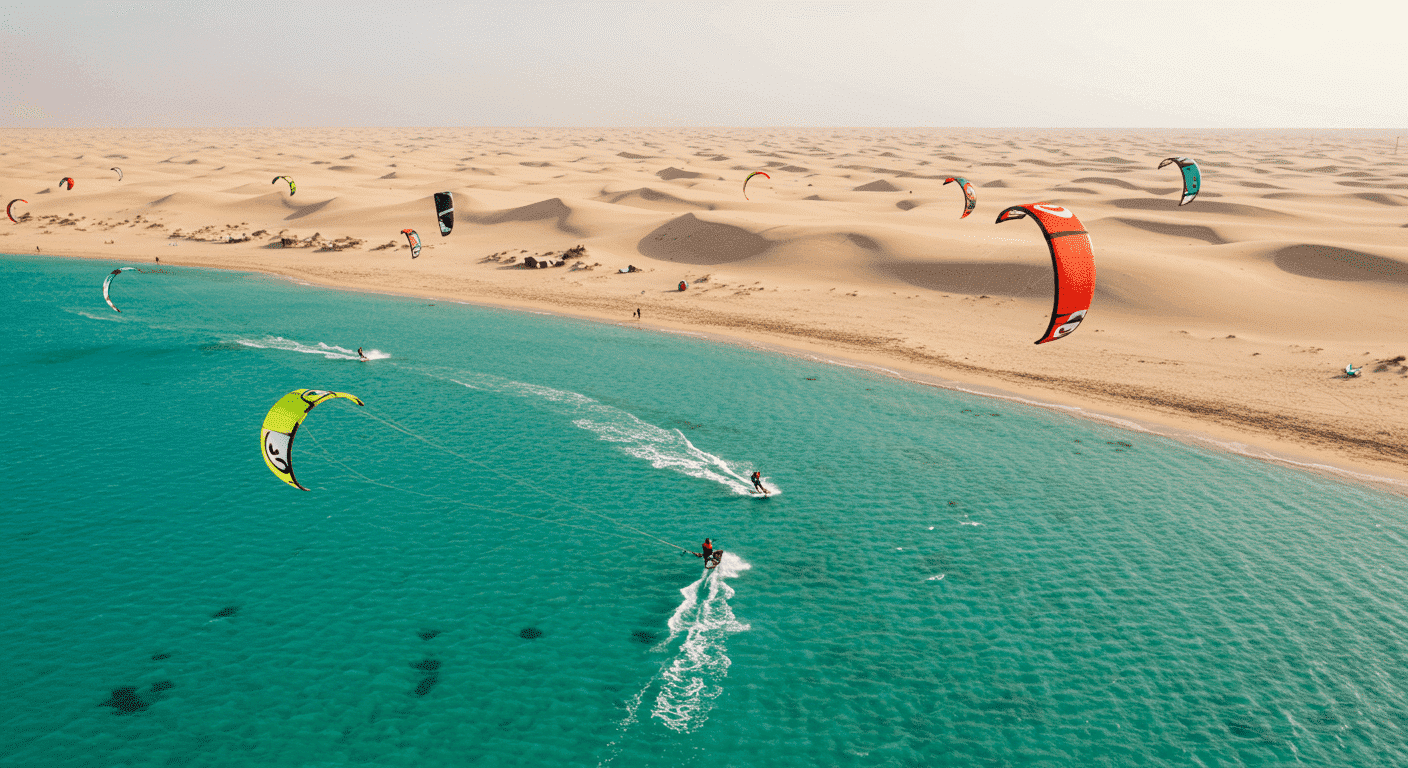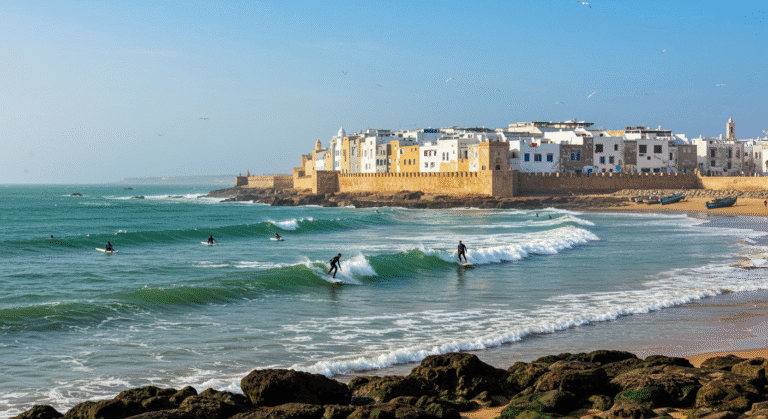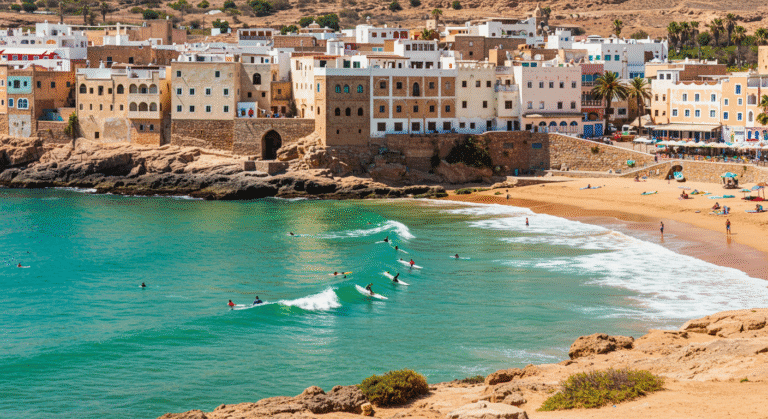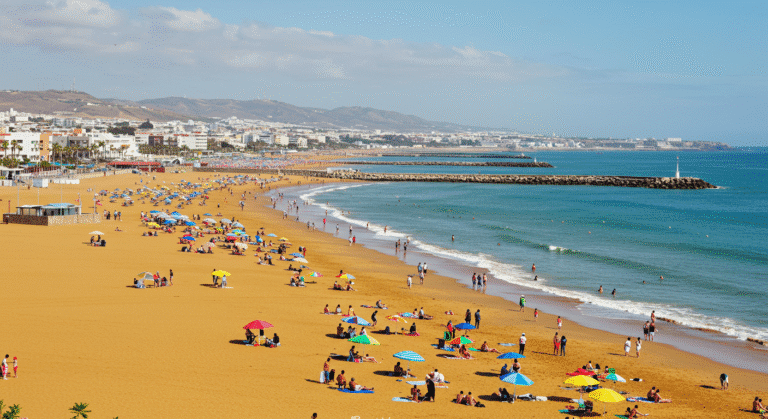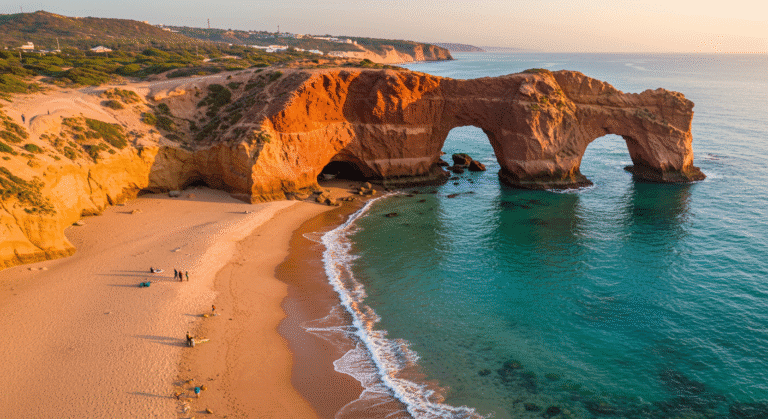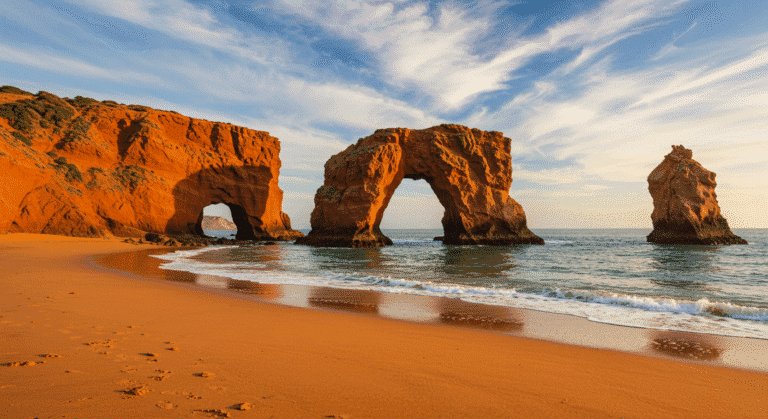Dakhla: Kitesurfing & Desert Beaches
Introduction
What if we told you that Morocco’s most extraordinary kitesurfing destination receives consistent 25-knot winds 320 days per year, yet remains virtually unknown to 89% of international travelers? Welcome to Dakhla, a spectacular peninsula jutting into the Atlantic Ocean where the Sahara Desert meets pristine turquoise lagoons. This remote outpost in Morocco’s disputed Western Sahara region has quietly evolved into one of the world’s premier wind sports destinations, attracting professional athletes and adventure seekers who’ve discovered its unique combination of reliable trade winds, flat-water lagoons, and desert landscapes.
Located 550 kilometers south of Agadir, Dakhla Morocco represents the ultimate escape from conventional tourism. The town sits on a narrow peninsula surrounded by Dakhla Bay, creating a natural wind tunnel that generates the consistent conditions that have made “Dakhla attitude” synonymous with world-class kitesurfing and windsurfing experiences. Unlike crowded European wind sports destinations, Dakhla beach offers endless space, pristine conditions, and authentic Saharan culture.
The transformation of this former Spanish colonial outpost into a kitesurfing mecca reflects Morocco’s commitment to adventure tourism development. Modern Dakhla airport connects this remote destination to major Moroccan cities, while a growing collection of specialized hotels and camps cater to wind sports enthusiasts seeking both performance and comfort in one of Africa’s most unique locations.
Travel Checklist / What to Pack
Essential Kitesurfing/Windsurfing Gear:
- Multiple kite sizes (9m, 12m, 15m recommended for varying wind conditions)
- Wetsuit (3/2mm minimum – Atlantic waters average 18-22°C)
- Harness, helmet, and impact vest for safety
- Waterproof action camera with extra batteries
- Kite repair kit and pump
Desert Climate Essentials:
- High SPF sunscreen (minimum SPF 50) – desert reflection intensifies UV exposure
- Wide-brimmed hat and UV-protective sunglasses
- Light, long-sleeved shirts for sun protection
- Breathable, quick-dry clothing for hot days and cool evenings
- Insulating layer for desert nights (temperatures can drop 20°C after sunset)
Photography & Documentation:
- Drone with extra batteries (check current regulations for Western Sahara)
- Waterproof phone case rated for saltwater exposure
- Portable solar charger for extended desert excursions
- Dust-proof camera bag for Saharan conditions
Pro Tips for Wind Sports Athletes: Pack multiple board options – choppy Atlantic conditions favor different setups than flat lagoon waters. Local wind patterns shift throughout the day, so versatile equipment maximizes water time.
Health & Safety:
- Personal first aid kit including reef-safe antiseptic
- Electrolyte supplements for high-activity desert conditions
- Reef-safe sunscreen to protect marine ecosystems
- Personal water purification tablets for desert excursions
Best Time to Visit
Optimal Wind Sports Season: March-October
Dakhla’s unique geographical position creates remarkably consistent wind conditions, with trade winds accelerating through the peninsula’s natural funnel effect. Professional kitesurfers consider March through October the “golden window” when daily winds average 20-30 knots with exceptional reliability.
Seasonal Breakdown:
Spring (March-May): Peak performance season with strong, consistent winds averaging 25 knots. Ocean temperatures reach comfortable 20-22°C. Tourist numbers remain 60% below peak season, ensuring uncrowded conditions and better accommodation rates.
Summer (June-August): Strongest wind conditions with daily averages exceeding 30 knots. Ocean temperatures peak at 23-24°C, perfect for extended water sessions. This represents peak season with 40% higher accommodation costs but guaranteed optimal conditions.
Autumn (September-November): Extended season with reliable 20-25 knot winds and warm water temperatures maintained from summer heating. September offers the year’s best balance of strong winds, warm water, and moderate tourist numbers.
Winter (December-February): Off-season for wind sports with lighter, less reliable winds averaging 15-20 knots. However, this period offers unique desert exploration opportunities, lower costs (accommodation drops 50%), and authentic cultural experiences with fewer tourists.
Data-Driven Insights: Meteorological data shows Dakhla experiences measurable winds (>15 knots) on 320 days annually, with only 45 days classified as “light wind” conditions. Wind direction remains remarkably consistent from the northeast, creating optimal side-shore conditions for both kitesurfing and windsurfing.
Cost Optimization: Visiting during shoulder months (March-April, September-October) provides 85% of peak wind conditions at 30% lower accommodation costs compared to summer peaks.
Step-by-Step Itinerary
Day 1: Arrival and Lagoon Introduction
Morning (8:00-12:00): Arrive at Dakhla airport and transfer to accommodation. Most visitors choose between desert camps offering authentic Saharan experiences or modern hotels providing contemporary comfort. Begin with equipment check and local wind pattern briefing from experienced local guides.
Take your first exploration of Dakhla’s famous lagoon, where turquoise waters stretch endlessly against red desert backdrops. The shallow, flat waters provide perfect conditions for beginners while offering freestyle opportunities for advanced riders.
Afternoon (12:00-18:00): First kitesurfing or windsurfing session in the protected lagoon waters. Local conditions typically build throughout the afternoon, with winds reaching optimal strength around 14:00. Professional instruction available for all levels, with specialized programs for different riding styles.
Evening (18:00-21:00): Experience your first Dakhla sunset from the peninsula’s tip, where desert dunes meet Atlantic waves. Local restaurants serve fresh seafood caught daily by traditional fishing fleets, paired with Moroccan specialties adapted to local Saharan influences.
Day 2: Atlantic Ocean Adventure
Early Morning (6:00-9:00): Sunrise session on the Atlantic side, where more challenging wave conditions test advanced skills. Ocean-side riding offers different experiences from lagoon conditions, with natural reef breaks creating varied water states throughout the day.
Morning (9:00-13:00): Explore Dakhla’s fishing port and traditional boat-building workshops. Local craftsmen create traditional fishing vessels using techniques unchanged for generations, offering authentic cultural immersion between wind sports sessions.
Visit the weekly market where nomadic traders sell traditional handicrafts, spices, and desert survival gear. Photography opportunities abound as traditional and modern lifestyles intersect.
Afternoon (13:00-17:00): Advanced riding session focusing on wave riding and freestyle maneuvers. Ocean conditions typically peak during mid-afternoon hours, with consistent swells combining with strong winds for optimal performance conditions.
Evening (17:00-20:00): Desert excursion to nearby dune formations for sand-boarding and traditional tea ceremony with local nomadic families. This cultural exchange provides insights into traditional Saharan life while offering spectacular photography opportunities.
Day 3: Desert Integration Experience
Full Day (8:00-18:00): Combine wind sports with desert exploration through guided 4×4 excursions. Visit traditional Sahrawi settlements where nomadic families maintain traditional lifestyles adapted to harsh desert conditions.
Discover hidden oases where underground springs create surprising pockets of vegetation within the Saharan landscape. These locations offer unique photography opportunities and insights into desert ecology.
Participate in traditional fishing expeditions with local crews, learning ancient techniques while contributing to sustainable tourism income for coastal communities.
Day 4: Advanced Skills and Exploration
Morning (8:00-13:00): Advanced skills workshop focusing on specific techniques like unhooking, handle passes, or wave riding depending on individual goals. Professional instruction adapts to personal progression needs and local conditions.
Afternoon (13:00-17:00): Self-guided exploration of remote lagoon areas accessible only during high tide periods. These hidden spots offer pristine conditions and isolation for experienced riders seeking ultimate freedom.
Evening (17:00-20:00): Sunset photography session from elevated desert viewpoints overlooking the entire Dakhla peninsula. The contrast between desert, lagoon, and ocean creates unique compositional opportunities.
Day 5: Cultural Immersion and Departure Preparation
Morning (8:00-12:00): Final wind sports session combined with equipment maintenance workshop. Learn basic repair techniques essential for extended desert adventures and future trips.
Afternoon (12:00-17:00): Cultural immersion experience with local Sahrawi families, including traditional music, handicraft workshops, and authentic meal preparation. These interactions provide deeper understanding of regional culture and history.
Purchase local handicrafts and specialties, supporting community-based tourism initiatives while acquiring unique souvenirs unavailable elsewhere.
Budget Breakdown
Budget Adventure (Per Person, 5 Days):
- Accommodation: €25-35/night (shared desert camp or basic guesthouse)
- Meals: €12-18/day (local restaurants and market food)
- Equipment Rental: €30-40/day (kite/windsurf gear)
- Transportation: €150-200 (flight from Casablanca + local transfers)
- Activities: €20-30/day (guided excursions and lessons)
- Total: €400-550
Mid-Range Experience (Per Person, 5 Days):
- Accommodation: €60-80/night (comfortable hotel or premium camp)
- Meals: €25-35/day (mix of local and international cuisine)
- Equipment Rental: €45-60/day (premium gear and professional instruction)
- Transportation: €200-300 (including domestic flights and private transfers)
- Activities: €40-60/day (private guides and specialized experiences)
- Total: €750-1,100
Luxury Desert Experience (Per Person, 5 Days):
- Accommodation: €120-200/night (luxury eco-lodge or premium resort)
- Meals: €50-80/day (gourmet dining with organic local ingredients)
- Equipment Rental: €80-100/day (latest equipment with personal coaching)
- Transportation: €400-600 (private transfers and premium flights)
- Activities: €80-120/day (exclusive experiences and private instruction)
- Total: €1,500-2,200
Money-Saving Strategies:
- Book accommodation directly with camps to avoid commission fees (often 15-20% savings)
- Travel during shoulder seasons (March-April, September-October) for 30% accommodation savings
- Combine group lessons to reduce individual instruction costs
- Purchase equipment packages including multiple days for better daily rates
Sustainable & Cultural Alternatives
Eco-Friendly Wind Sports: Partner with local environmental organizations working to protect Dakhla’s unique marine ecosystem. Several operators offer carbon-neutral packages including reforestation projects that offset travel emissions.
Family Adventures: Wide, shallow lagoon areas provide safe environments for children to learn basic wind sports techniques. Local families often visit during weekends, creating natural cultural exchange opportunities.
Solo Traveler Programs: Join international wind sports groups that converge in Dakhla during peak seasons. These communities provide safety, social connections, and shared learning experiences while maintaining individual adventure goals.
Digital Nomad Hub Development: Several desert camps now offer high-speed internet connectivity and dedicated workspace areas. The inspiring desert landscape and consistent wind conditions create unique environments for remote work combined with daily adventure activities.
Traditional Craft Learning: Participate in workshops with local artisans learning traditional weaving, leather work, and jewelry making techniques. These skills connect visitors to authentic Saharan culture while supporting traditional livelihoods.
Conservation Volunteering: Contribute to sea turtle monitoring programs, marine debris cleanup initiatives, and desert reforestation projects that protect Dakhla’s unique ecosystem while providing meaningful travel experiences.
Food & Dining Suggestions
Must-Try Local Specialties:
Fresh Seafood Excellence: Daily catches include sea bream, sole, and lobster, typically grilled over traditional charcoal and seasoned with local herbs and spices. The “plateau de fruits de mer” (seafood platter) represents exceptional value and freshness impossible to find inland.
Saharan-Influenced Moroccan Cuisine: Traditional tagines adapted to desert conditions feature preserved meats, dried fruits, and hardy vegetables that thrive in arid climates. Camel meat tagines offer unique flavors for adventurous palates.
Nomadic Specialties: Experience traditional Sahrawi cuisine including camel milk cheese, dates stuffed with nuts, and traditional bread baked in sand ovens. These authentic flavors connect visitors to ancient desert survival traditions.
Recommended Dining Experiences:
Restaurant Sahraoui: Family-operated establishment serving authentic Sahrawi dishes with stunning lagoon views. Their grilled fish with desert herbs creates unforgettable flavor combinations while supporting local fishing communities.
Café Moussem: Traditional gathering place where local wind sports enthusiasts share daily conditions over strong coffee and traditional pastries. The authentic atmosphere provides genuine cultural immersion and local insights.
Desert Camp Dining: Many accommodations offer traditional outdoor dining experiences under star-filled skies. Communal meals create opportunities for cultural exchange while experiencing authentic nomadic hospitality.
Sensory Dining Recommendations: Time evening meals with sunset views over the lagoon, when golden light transforms the desert landscape into magical photography and dining backdrops. Traditional mint tea ceremonies provide perfect transitions between active days and peaceful evenings.
Common Mistakes to Avoid
Equipment and Safety Errors: Never underestimate Dakhla’s wind power – many visitors bring inadequate smaller kites thinking they need light-wind equipment. Consistent strong winds require appropriate gear sizing and safety equipment including impact vests.
Cultural Misunderstandings: Always ask permission before photographing local people, especially women and children. Offering to share photos via email or social media often leads to wonderful connections and genuine friendships.
Navigation and Planning Mistakes: Don’t rely solely on GPS in remote desert areas – GPS accuracy can be compromised, and cell service becomes spotty outside town centers. Always inform someone of planned routes and expected return times.
Weather Underestimation: Desert temperature variations can exceed 25°C between day and night. Pack appropriate layers even during summer months, as evening temperatures drop significantly with desert cooling.
Booking and Timing Errors: Avoid booking accommodation without confirming wind conditions for your specific dates. While Dakhla offers consistent winds, occasional weather patterns can create light-wind periods. Flexible booking allows adaptation to optimal conditions.
Health and Hydration Oversights: Desert conditions combined with physical activity create extreme dehydration risks. Consume 3-4 liters of water daily, and include electrolyte supplements to maintain performance and health.
Safety & Travel Tips
Water Sports Safety: Always use proper safety equipment including helmets and impact vests. Dakhla’s consistent strong winds can overwhelm inexperienced riders quickly. Professional instruction is highly recommended for first-time visitors.
Desert Safety Protocols: Never venture into remote desert areas alone. Carry GPS beacons, extra water, and emergency supplies for any desert excursions. Local guides understand weather patterns and terrain hazards essential for safe exploration.
Medical Preparedness: The nearest comprehensive medical facility is in Laayoune, approximately 2 hours from Dakhla. Carry comprehensive first aid supplies including treatments for cuts, sprains, and dehydration. Travel insurance covering adventure sports activities is essential.
Communication and Connectivity: Maroc Telecom provides the most reliable coverage in Dakhla and surrounding areas. Purchase local SIM cards for data access and emergency communication. Offline map applications work excellently for desert navigation.
Transportation Safety: Road conditions between major towns are generally excellent, but remote area access requires 4×4 vehicles. If renting equipment, choose operators with maintenance records and emergency support capabilities.
Political Considerations: Western Sahara remains a disputed territory with occasional political tensions. Stay informed about current conditions, avoid political discussions, and respect local sensitivities regarding territorial status.
Conclusion
Dakhla represents Africa’s ultimate wind sports destination, combining world-class conditions with authentic Saharan culture and pristine natural beauty. From mastering new kitesurfing techniques in perfect flat-water conditions to experiencing traditional nomadic hospitality under star-filled desert skies, this remote Moroccan peninsula offers adventures impossible to find elsewhere.
Ready to experience the legendary “Dakhla attitude” for yourself? Share your wind sports goals and desert adventure dreams in the comments below, or subscribe to our newsletter for exclusive access to seasonal wind condition reports and insider equipment recommendations.
FAQs
Do I need special permits to visit Dakhla in Western Sahara?
Dakhla is accessible with standard Moroccan tourist visas. No special permits are required for tourism activities, though organized desert excursions may require local guide arrangements.
What’s the minimum skill level required for kitesurfing in Dakhla?
Dakhla accommodates all skill levels, but consistent strong winds make it particularly rewarding for intermediate to advanced riders. Beginners can learn in protected lagoon areas with professional instruction.
How reliable are the wind conditions throughout the year?
Dakhla experiences consistent winds (15+ knots) on approximately 320 days annually, with optimal conditions (20-30 knots) occurring March through October. This makes it one of the world’s most reliable wind sports destinations.
What accommodation options exist for wind sports travelers?
Options range from authentic desert camps (€25-40/night) to luxury eco-lodges (€120-200/night). Many accommodations specialize in wind sports travelers with equipment storage, repair facilities, and condition updates.
Is Dakhla suitable for families with children?
Yes, the shallow lagoon areas provide safe environments for children to learn water sports. Many local families visit during weekends, creating natural cultural exchange opportunities.
What equipment rental options are available locally?
Dakhla offers comprehensive equipment rental including kites, boards, wetsuits, and safety gear. Quality ranges from basic to professional-grade equipment, with many shops offering latest-model gear.
How do I get to Dakhla from major international airports?
Fly into Casablanca or Agadir, then take domestic flights to Dakhla airport (villa cisneros). Royal Air Maroc operates regular services, with journey times of 2-3 hours from major Moroccan cities.
What’s the local currency and payment methods?
Moroccan Dirham (MAD) is the local currency. Credit cards are accepted at major hotels and restaurants, but carry cash for local markets, equipment rentals, and desert excursions. ATMs are available in Dakhla town center.
Are there cultural considerations for wind sports activities?
Standard beachwear is acceptable for water sports activities. However, dress modestly when visiting local communities or markets. Respect local customs and always ask permission before photographing people.
What emergency services are available in Dakhla?
Basic medical services are available locally, with comprehensive facilities in Laayoune (2 hours away). Travel insurance covering adventure sports activities is strongly recommended for all visitors.
